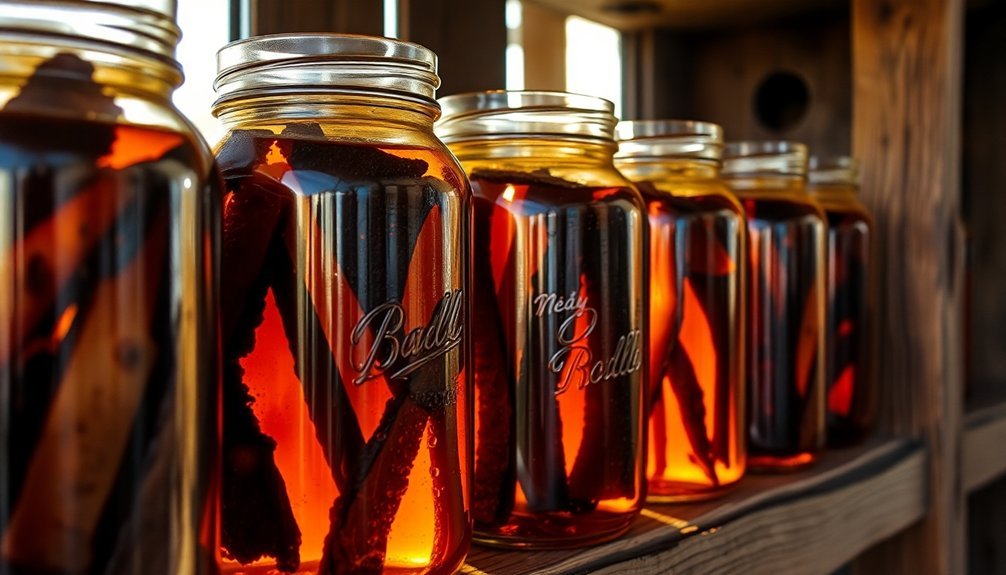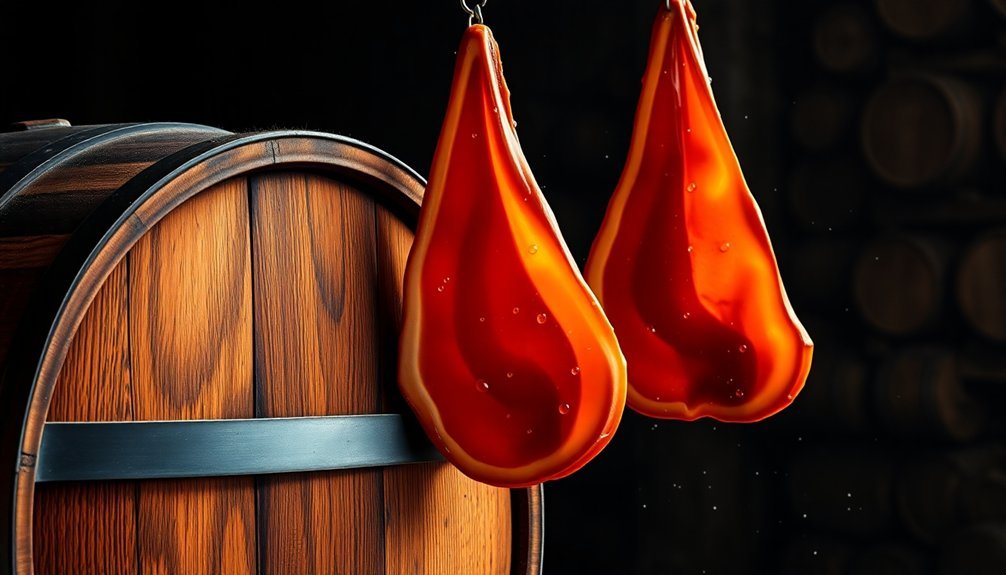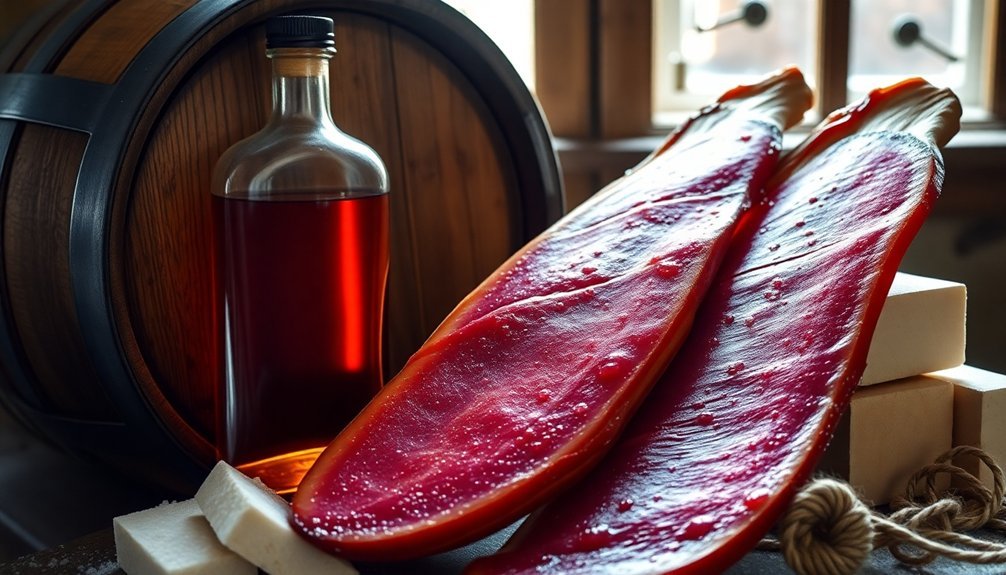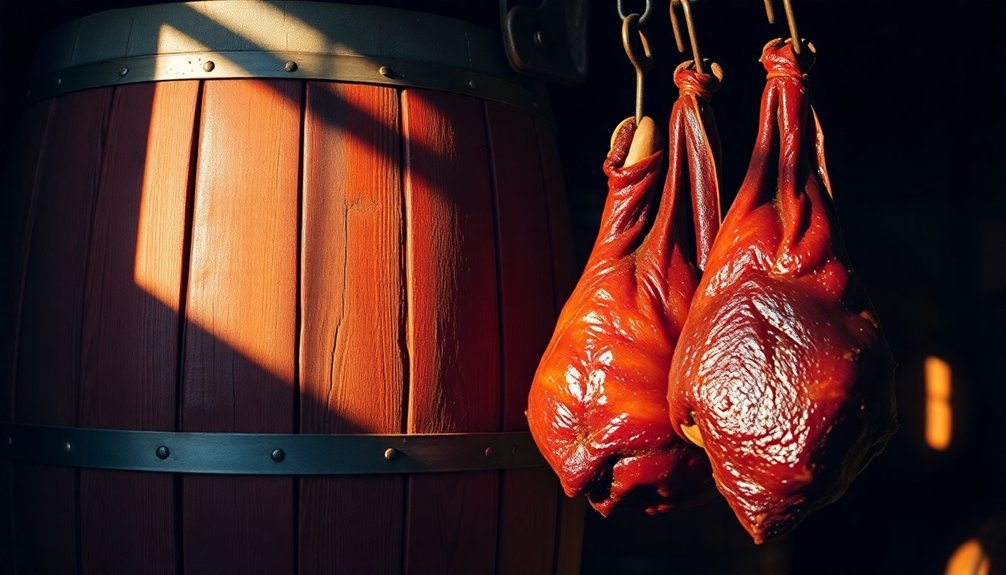Booze can preserve meat for centuries because of its powerful antimicrobial properties. When you soak meat in high-proof alcohol like brandy or rum (50% ABV or higher), the alcohol molecules attack and destroy bacterial cell membranes while denaturing proteins that microorganisms need to survive. This preservation technique dates back to ancient Mesopotamia, where people discovered alcohol's ability to keep food edible for extended periods. You'll need the right concentration – typically 60-80% alcohol works best – and proper storage conditions for ideal results. The fascinating chemistry behind this time-tested method reveals even more secrets about alcohol's preservative power.
Ancient Origins of Alcohol Preservation

The story of alcohol preservation dates back to when our ancestors stumbled upon fermentation by accident. When rain-soaked barley grains fermented into beer around 3,400 BCE in Mesopotamia, it marked humanity's first steps into understanding how alcohol could prevent food spoilage.
You'll find evidence of this discovery in ancient Mesopotamian accounting documents from around 3,000 BCE, where beer production was already a well-established practice. Ancient societies discovered that spontaneous fermentation processes occurred naturally, leading to the development of various preservation techniques. While you might think alcohol preservation was widespread, it actually wasn't the go-to method for keeping food edible. The high cost and scarcity of food-grade alcohol meant that other preservation techniques, like drying and fermentation, were more common.
What's fascinating is that ancient peoples didn't just use alcohol for preservation – they discovered multiple fermentation processes that helped them keep food fresh without fire or fuel. They'd ferment everything from fruits to cabbage, creating foods like sauerkraut and kimchi.
In arctic regions, where traditional preservation methods weren't always effective, alcohol preservation proved particularly valuable. The practice gained more traction as trade routes expanded, bringing new preservation techniques and materials across different cultures.
How Alcohol Kills Bacteria
When you soak meat in alcohol, you're releasing a powerful antimicrobial attack that disrupts bacterial cell membranes and destabilizes their structure.
The alcohol molecules tear through the cell walls of bacteria while simultaneously denaturing their proteins, fundamentally destroying these microorganisms from both outside and inside. This process is similar to how wine kills pathogens that could otherwise cause food poisoning.
You're also witnessing a chemical process where alcohol, especially when mixed with water, unravels bacterial proteins and breaks down their cellular components, making it impossible for them to survive.
Membrane Disruption In Microbes
Piercing through bacterial defenses, alcohol acts as a potent antimicrobial agent by dissolving cell membranes and destroying harmful microorganisms. When you expose bacteria to high concentrations of alcohol (60-80%), the hydroxyl groups in the alcohol molecules attack the lipid bilayer of bacterial membranes, causing devastating structural damage. This interaction forces cellular contents to leak out, ultimately leading to the microbe's death.
However, some bacteria like Staphylococcus aureus can develop enhanced biofilm formation when exposed to lower concentrations of alcohol, making them harder to eliminate. You'll find that different types of alcohol vary in their effectiveness. While 70% isopropanol delivers a swift knockout punch to bacteria, lower concentrations like 40% ethanol work more slowly but can still destabilize cell membranes over time. Red wine's combination of alcohol and acidic pH makes it particularly effective against certain bacteria like salmonella.
- Watch in amazement as alcohol molecules tear through bacterial walls like microscopic wrecking balls
- Marvel at nature's elegant solution for food preservation, used by cultures for millennia
- Witness the invisible battle between alcohol and microbes that keeps your food safe
The concentration matters greatly – while 10% alcohol barely affects bacteria, concentrations above 60% can eliminate threats within minutes by completely disrupting their cellular structure and metabolic functions.
Chemical Protein Denaturation Process
Diving deeper into alcohol's antimicrobial action, you'll find that its protein-destroying capabilities form the cornerstone of its effectiveness. When alcohol molecules interact with proteins in bacteria, they'll break down vital hydrogen bonds that maintain the protein's structure.
You'll see alcohol molecules competing with amino acids, forming new hydrogen bonds that disrupt the protein's natural shape.
What's particularly interesting is how alcohol attacks the hydrophobic core of proteins. These water-fearing parts typically huddle inside the protein structure, but alcohol forces them out of hiding.
When this happens, you're witnessing a fundamental breakdown of the protein's architecture that's critical for cellular function.
The type and concentration of alcohol matter greatly in this process. While ethanol and isopropanol effectively denature proteins at the right concentrations, you'll find that some alcohols, like glycerol, can actually protect protein structures.
When you're preserving meat with alcohol, you're fundamentally exploiting this protein-destroying mechanism. The alcohol disrupts bacterial proteins so thoroughly that microorganisms can't survive, which is why properly preserved meat can last for remarkably long periods.
Cell Wall Breakdown Mechanisms
The destructive power of alcohol on bacterial cell walls stems from its unique molecular structure. When alcohol molecules come into contact with bacteria, they act like molecular wrecking balls, thanks to their ability to bond with both water and fat. You'll find these molecules attacking the peptidoglycan in bacterial cell walls, which is fundamentally the armor that keeps bacteria alive and functioning.
What makes this process particularly fascinating is how alcohol specifically targets gram-positive bacteria, which have thicker peptidoglycan layers. It's like having a bigger target to hit, making these bacteria more vulnerable to alcohol's destructive effects. You need at least 40% concentration for significant impact, though 60-80% proves most effective.
- Your meat stays preserved because alcohol mercilessly tears apart bacterial defenses, leaving them exposed and helpless.
- When bacteria lose their cell walls, they're fundamentally stripped naked in a hostile environment.
- Each alcohol molecule becomes a tiny executioner, systematically dismantling bacterial protection.
The process is even more effective when combined with acidic conditions, like those found in red wine, which brings additional bacteria-fighting properties beyond just its alcohol content. This dual-action approach helps explain why alcohol has been such a reliable preservative throughout history.
Best Spirits for Meat Preservation

You'll find brandy is a time-tested spirit for meat preservation, with centuries of traditional use proving its effectiveness.
Rum offers robust preservation power while adding rich flavors, though you must keep it properly chilled for food safety.
High-proof vodka works particularly well for preserving meat because of its neutral taste and potent alcohol content, typically ranging around 70% in preserving applications.
Historical Brandy Benefits
Preserved throughout history in brandy's potent embrace, meat found a reliable guardian in this popular spirit during the 19th century and beyond.
You'll find that brandy's effectiveness wasn't just a matter of chance – its high alcohol content actively inhibited bacterial growth while dehydrating the meat, creating a hostile environment for spoilage.
The preservation method proved remarkably versatile. You'd typically store your brandy-preserved meats in glass containers sealed with cork, wax, or resin, often wrapped in canvas bags for added protection.
Notable scientists and explorers, including René-Antoine Ferchault de Réaumur and Maria Sybilla Merian, relied on this technique for preserving specimens during their groundbreaking expeditions.
- Your ancestors trusted brandy to protect their precious mincemeat, combining it with fruits and spices for flavorful preservation.
- You'd find comfort knowing that brandy's natural chemistry worked tirelessly to denature proteins and disrupt cell membranes.
- You could enhance preservation by adding alum or ammonium chloride, making your meat last even longer.
This time-tested method wasn't limited to meat alone – it extended to fruits, creating a versatile preservation technique that served both culinary and scientific purposes.
Rum's Preservative Power
Sporting a potent alcohol content above 50% ABV, rum stands as one of the most effective spirits for meat preservation. When you submerge raw meat in high-proof rum, the alcohol denatures proteins and disrupts microbial cell membranes, effectively sterilizing the meat while creating unique flavor compounds through esterification.
| Preservation Factor | Effect on Meat |
|---|---|
| Alcohol Content | Denatures proteins, kills microbes |
| Chemical Reaction | Creates flavor-enhancing esters |
| Extraction Process | Removes impurities from meat |
| Storage Method | Prevents oxidation under pressure |
You'll find this preservation technique deeply rooted in Demerara's rum-making tradition, where producers have long used raw meat in casks to enhance their spirits' character. The process isn't just about preservation – it's a two-way exchange where the meat contributes to the rum's profile while being preserved.
When trying this method, you'll need to monitor the process carefully. The meat will quickly change color and break down, requiring centrifugation after several days. For best results, you should de-aerate the infusion and maintain it under pressure to prevent oxidative rancidity.
High-Proof Vodka Techniques
High-proof vodka stands out as the purest preservation spirit, clocking in at an impressive 190 proof (95% ABV). Through intense distillation and filtering processes using materials like activated charcoal or diamond dust, vodka achieves an unmatched level of neutrality that's perfect for preserving meat without altering its natural flavors.
When you're looking to preserve meat with vodka, you'll want to create a solution that combines its bacteria-fighting power with proper tissue hydration. You can either immerse your meat directly in a vodka-water mixture or apply it to the surface as part of a preservation process. Unlike rum or brandy, vodka won't mask your meat's inherent flavors with strong competing notes.
- You'll marvel at how vodka's high ethanol content actively dehydrates harmful microorganisms while maintaining your meat's moisture.
- You'll appreciate the spirit's ability to denature proteins, creating a more stable preservation environment.
- You'll be amazed by the way vodka concentrates your meat's natural flavors during the preservation process.
The key to vodka's effectiveness lies in its purity and high alcohol content, making it your ideal choice for long-term meat preservation when flavor neutrality matters.
Traditional Preservation Methods and Recipes
Ancient civilizations mastered numerous preservation techniques that kept meat edible long before modern refrigeration existed. You'll find that many of these methods worked by removing moisture or creating environments where bacteria couldn't thrive.
Dehydration was a cornerstone technique, with the Incas perfecting freeze-drying at high altitudes. You can still see this principle at work in modern jerky production, where meat is soaked in vinegar and spices before being dried in the sun.
Curing and salting were equally significant – you'd rub meat with salt or saltpetre to draw out moisture and maintain color, while brining involved soaking larger cuts in saltwater solutions.
Smoking wasn't just about flavor; it protected outer fat layers from turning rancid and often complemented other preservation methods. You'd find smokehouses on most 18th-century farms, where families would preserve large quantities of meat for extended periods.
Other traditional approaches included potting, where you'd pack cooked meat into jars and seal it with butter or lard, and jugging, which involved stewing meat in vinegar or wine before storing it in earthenware containers.
Chemistry Behind Long Term Storage

The chemical interaction between alcohol and meat creates a powerful preservation effect that's far more complex than simply soaking food in spirits.
When alcohol meets meat, it attacks microorganisms that cause spoilage by disrupting their cell membranes and coagulating their proteins. You'll find that alcohol fundamentally creates a hostile environment where bacteria, yeasts, and molds can't survive or multiply.
The preservation process works through a delicate balance of dehydration and protein modification. As alcohol replaces water in the meat's cells, it denatures proteins and hardens tissues, effectively "locking" the meat's structure in place.
You'll need to maintain the right concentration of alcohol – too little won't stop microbial growth, while too much can damage the meat's texture.
- You're witnessing a microscopic battle where alcohol molecules wage war against decay-causing organisms
- You're participating in a centuries-old tradition that's kept food safe long before refrigeration
- You're utilizing the same chemical principles that scientists use to preserve specimens in laboratories
The key to successful alcohol preservation lies in maintaining this chemical balance over time, often requiring periodic changes of the alcohol solution to guarantee its continued effectiveness in protecting the meat.
Modern Applications of Alcohol Curing
While the chemistry of alcohol preservation remains fascinating, modern food safety standards have largely moved away from this method. You'll find that today's meat preservation techniques focus on more reliable and cost-effective approaches, primarily using salt-based curing methods.
| Modern Method | Key Benefits |
|---|---|
| Wet Curing | Uniform distribution, better control of salt levels |
| Dry Curing | Ideal for small cuts, traditional flavor development |
| Combination Curing | Faster process, reduced spoilage risk |
| Premixed Cures | Precise nitrite levels, safer for home use |
| Salt-Based Solutions | Proven effectiveness, lower cost than alcohol |
If you're looking to preserve meat safely, you'll want to stick with these contemporary methods rather than alcohol preservation. The risks associated with alcohol curing, including potential botulism and survival of extremophilic bacteria, make it impractical for food preservation. Additionally, the high cost of food-grade ethanol makes it commercially unfeasible. Instead, you'll achieve better results using traditional curing methods that combine salt, nitrates, and nitrites. These proven techniques not only preserve the meat effectively but also contribute to desired flavor profiles and that characteristic cured color that consumers expect.
Safety and Storage Guidelines

Proper storage and handling of meat stands as the cornerstone of food safety, whether you're working with fresh cuts or preserved products.
You'll want to keep fresh meat at temperatures below 38°F to inhibit bacterial growth, while ensuring proper air circulation in your refrigerator. Don't wash your meat before storage, as added moisture can create an ideal environment for bacteria to thrive.
For long-term preservation, you've got several reliable options. You can freeze meat at 0°F or lower, making sure it's wrapped tightly to prevent freezer burn. Different meats have varying storage times – beef can last 6-12 months, while pork typically stays good for 6 months.
- You're fighting against time when storing meat – every minute above 40°F increases spoilage risk.
- Your ancestors knew the power of preservation – smoking, drying, and fermenting aren't just trends, they're survival techniques.
- You're one poorly stored meal away from foodborne illness – proper storage isn't optional, it's essential.
Remember to keep your storage containers well-ventilated and uncluttered.
If you're using traditional preservation methods like curing or smoking, you'll still need to follow proper storage guidelines to maintain safety and quality.
Frequently Asked Questions
Can Alcohol-Preserved Meat Spoil if Exposed to Extreme Temperatures?
Yes, your alcohol-preserved meat can spoil when exposed to extreme temperatures. High heat accelerates chemical reactions, compromises preservation, and promotes bacterial growth, even in alcohol. You'll need proper temperature control to prevent spoilage.
Does Alcohol-Preserved Meat Retain Its Original Texture After Centuries?
You won't find meat retaining its original texture after centuries, regardless of alcohol preservation. The protein structures break down over time, leading to significant changes in both firmness and fiber composition.
How Does the Alcohol Content Change in Preserved Meat Over Time?
You'll notice the alcohol content gradually decreases as it evaporates and gets absorbed by the meat. While it diminishes over time, there's usually enough remaining alcohol to maintain preservation and antimicrobial properties.
Can You Get Intoxicated From Eating Alcohol-Preserved Meats?
You won't get drunk from eating alcohol-preserved meats. The amount of alcohol you'd consume is minimal, and most of it evaporates during cooking, though you might taste slight traces of alcohol flavor.
What's the Oldest Recorded Instance of Successfully Preserved Alcohol-Cured Meat?
You won't find a specific oldest recorded instance of alcohol-preserved meat, as this wasn't a common historical preservation method. Ancient cultures primarily relied on salt, smoking, and other traditional techniques for meat preservation.
In Summary
You've now learned how alcohol preservation has evolved from ancient methods to modern applications. While you won't find many booze-preserved meats in today's supermarkets, understanding this technique adds another tool to your preservation toolkit. Remember to follow proper safety guidelines if you're experimenting with alcohol curing, and always use food-grade spirits. Whether it's historical curiosity or practical application, alcohol preservation remains a fascinating intersection of food science and chemistry.





Leave a Reply